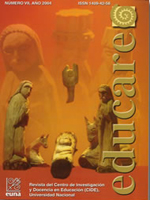Antes y después de las inteligencias múltiples
DOI:
https://doi.org/10.15359/ree.2004-7.4Abstract
In this article, a contrast between the traditional concept of intelligence and Gardner`s concept of multiple intelligences is discussed. The most significant details about the traditional educational system and the new one are also contrasted. After this, Gardner`s multiple intelligences are presented together with a proposal about how to implement this theory in the classroom for the benefit of the national educational community.
References
Antunes, C. (1999). Estimular las inteligencias múltiples. Qué son, cómo se manifiestan, cómo funcionan. Madrid: Ediciones Narcea.
Armstrong, T. (1994). Las inteligencias múltiples en el aula. Buenos
Aires: Editorial Manantial.
Campbell, B. The Multiple Intelligences Handbook. Lessons, Plans and
More ... USA: Campbell & Associates.
Campbell, L.; Campbell, B. y Dickenson, D. (2000). Inteligencias
múltiples. Usos prácticos para la enseñanza y el aprendizaje. Buenos Aires: Editorial Troquel.
Cañas, R. (mayo, 2001). El liderazgo ante los nuevos paradigmas
filosófico-pedagógicos. Acta académica, 65-77.
Cazau, P. Estilos de aprendizaje: el modelo de las inteligencias múltiples. Disponible en: http://pcazau.galeon.com/guia_esti06.htm.
Gardner, H. (2001). La inteligencia reformulada. Las inteligencias
múltiples en el S. XXI. Trad. Genís Sánchez Barberán. Barcelona: Ediciones Paidós Ibérica.
Gardner, H. (1993). Multiple Intelligences. The Theory in Practice. New
York: Basic books.
HernándezArce, G. (1992). Los paradigmas de la psicología educativa.
México: PROMESUP-OEA-ILCE.
Itkin, S. (set., 1997). Howard Gardner. La Teoría de las inteligencias
múltiples. Novedades educativas. Año 9 (81): 56.
Itkin, S. La teoría de las inteligencias múltiples yla educación. Disponible en: http://www.monografías.com/trabajos6/inmu/inmu.shtml.
Méndez, Z. (1998). Aprendizaje y cognición. San José, Costa Rica:
EUNED.
Project Zero. (2003). History of Project Zero. Disponible en: http://
www.pz.harvard.edu/History/History.htm
Real Academia Española (2001). Diccionario de la lengua española.
Madrid: Editorial Espasa Calpe.
Tonucci, F. (1996). ¿ Ense11ar o aprender? Buenos Aires: Editorial Losada.
Published
How to Cite
Issue
Section
License
1. In case the submitted paper is accepted for publication, the author(s) FREELY, COSTLESS, EXCLUSIVELY AND FOR AN INDEFINITE TERM transfer copyrights and patrimonial rights to Universidad Nacional (UNA, Costa Rica). For more details check the Originality Statement and Copyright Transfer Agreement
2. REUTILIZATION RIGHTS: UNA authorizes authors to use, for any purpose (among them selfarchiving or autoarchiving) and to publish in the Internet in any electronic site, the paper´'s final version, both approved and published (post print), as long as it is done with a non commercial purpose, does not generate derivates without previous consentment and recognizes both publisher's name and authorship.
3. The submission and possible publication of the paper in the Educare Electronic Journal is ruled by the Journal’s editorial policies, the institutional rules of Universidad Nacional and the laws of the Republic of Costa Rica. Additionally, any possible difference of opinion or future dispute shall be settled in accordance with the mechanisms of Alternative Dispute Resolution and the Costa Rican Jurisdiction.
4. In all cases, it is understood that the opinions issued are those of the authors and do not necessarily reflect the position and opinion of Educare, CIDE or Universidad Nacional, Costa Rica. It is also understood that, in the exercise of academic freedom, the authors have carried out a rogorous scientific-academic process of research, reflection and argumentation thar lays within the thematic scope of interest of the Journal.
5. The papers published by Educare Electronic Journal use a Creative Commons License:














 The articles published by Educare Electronic Journal can be shared with a Creative Commons License:
The articles published by Educare Electronic Journal can be shared with a Creative Commons License: 



